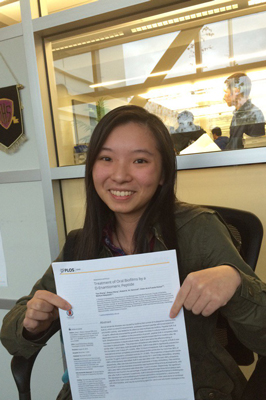Vancouver senior-high student Tian (Sally) Zhang has the distinction of being listed as the first author of a UBC Dentistry research paper, “Treatment of Oral Biofilms by a D-Enantiomeric Peptide,” published in PLOS ONE.† The research looked at new antimicrobial peptides and their antimicrobial properties, and the paper demonstrates that this peptide is a promising agent for future oral antibiofilm strategies.

Tian (Sally) Zhang
Zhang, a student at University Hill Secondary School, was one of 10 Vancouver school students chosen by the Sanofi Biogenius Canada (SBC) program. SBC challenges high-school students to carry out groundbreaking research projects in the field of biotechnology. Based on their application and research plans, those selected are matched with local mentors who give the students hands-on research experience in a professional lab setting.
From October 2015 to November 2016, Zhang worked on this project under the supervision of Dr. Markus Haapasalo, professor and chair of the Division of Endodontics at UBC Dentistry. Zhang did the work in Haapasalo’s lab, in collaboration with Dr. Robert Hancock, professor in the Department of Microbiology & Immunology, Faculty of Science, and director of the UBC Centre for Microbial Diseases and Immunity Research.
The experiments used biofilm models that were developed in the Haapasalo lab, and peptide DJK-5 from the R.E.W. Hancock Laboratory. Biofilm killing tests involving the new antimicrobial peptides, a colony forming units test and a minimal inhibitory concentration test were performed.
Zhang’s contributions to the research project were immense. Along with tasks related to data curation, formal analysis, investigation, methodology, software, validation and visualization, she wrote the original draft of the paper, and also reviewed and edited subsequent iterations.
“I am extremely grateful for Prof. Haapasalo’s guidance, as well as the kindness of other lab members, who made the time in the lab so memorable,” Zhang says. “It has been very exciting for me, as a high school student, to carry out research in a university lab. I not only learned how to perform experiments, but also developed a deeper understanding of the research process. I learned that it is very challenging to produce results that are repeatable and reliable. This has been an invaluable learning experience.”
Says Haapasalo: “It was an interesting experiment to have a high-school student embedded in the lab and working on a project that was important for us. Sally was quite exceptional: she learned quickly, was thorough and wanted to know about the science behind the project, enjoyed being part of the group of researchers, and communicated well. She produced very solid, reliable data—probably the highest antibiofilm activity against oral biofilms reported in the literature so far— which allowed us to publish in the prestigious PLOS ONE journal. I would take Sally back any time.”
†Zhang T, Wang Z, Hancock REW, de la Fuente-Núñez C, Haapasalo M. (2016). Treatment of oral biofilms by a D-enantiomeric peptide. PLOS ONE. doi:10.1371/journal.pone.0166997.